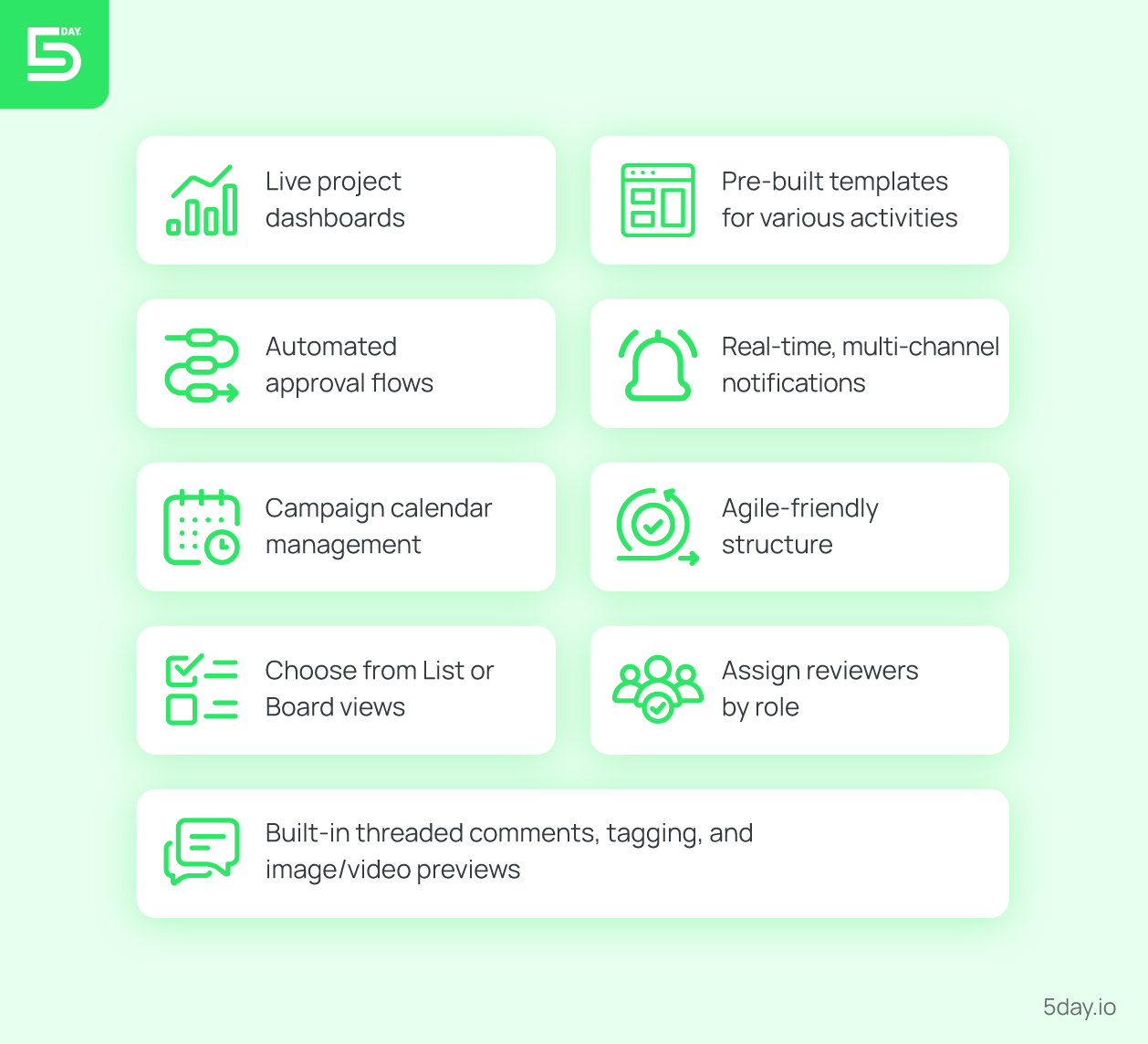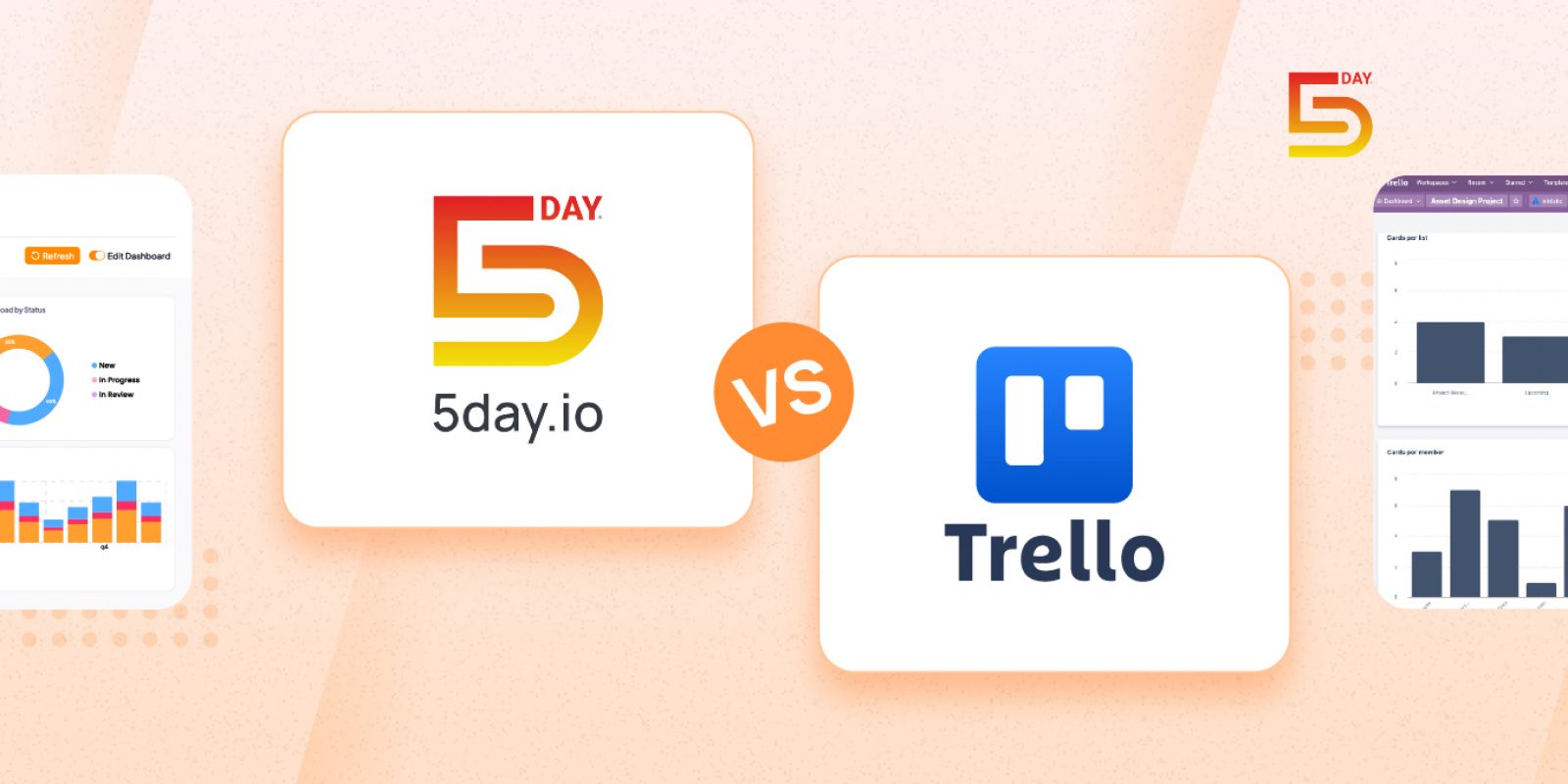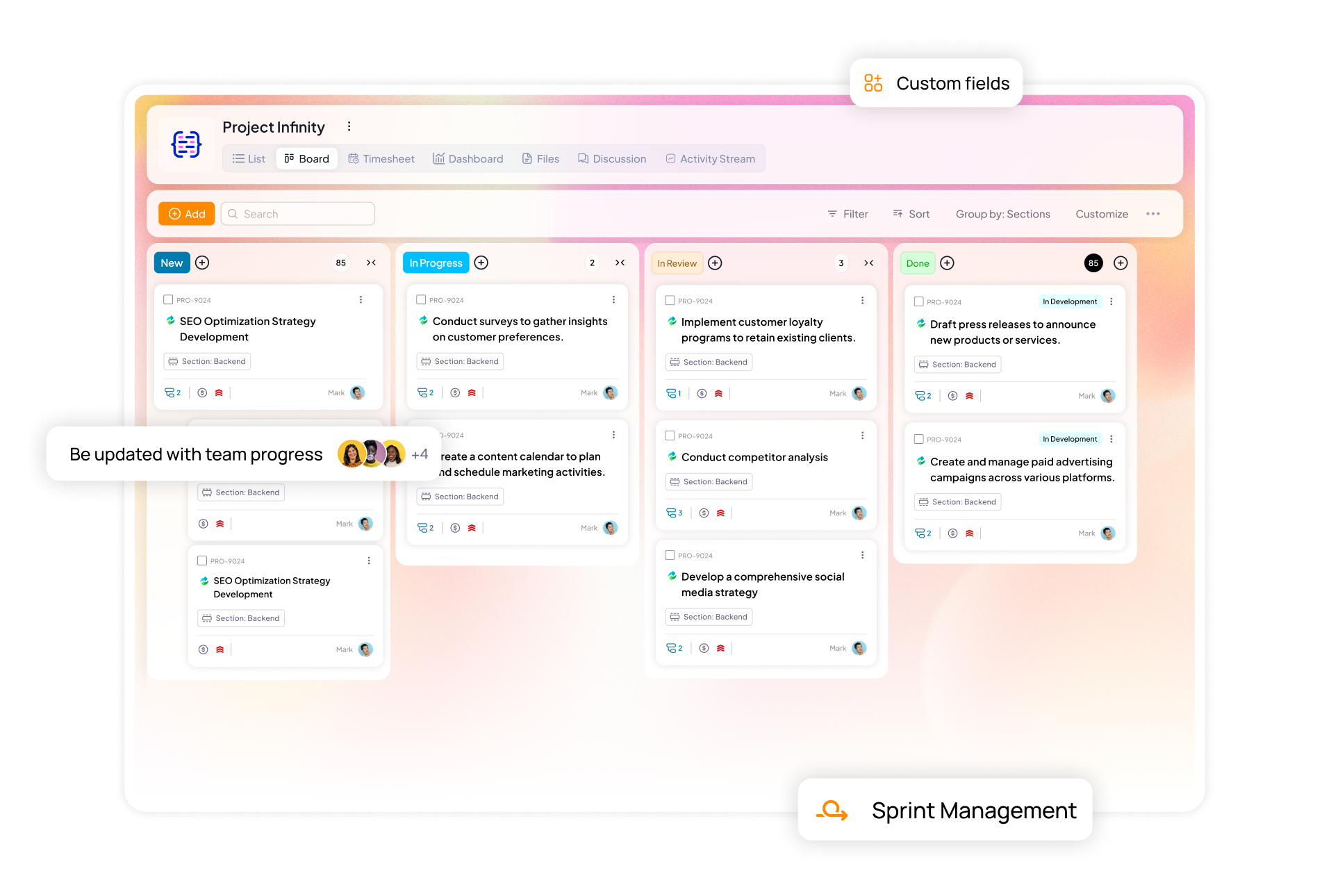You’re constantly exhausted because you’re doing too much that was never meant to be your core job. Be it chasing down files, or digging through endless threads, or collating reports from multiple people to send a weekly summary email.
Marketing teams are drowning in systems that weren’t built for how they actually work. Brilliant, creative people held back by tools that create more friction than flow.
That’s where 5day.io steps in as a remedy to that chaos. It is a centralized space where your people, your process, system and your momentum finally align. This is how marketing was meant to feel. How do we do that?
Let’s cover this in detail in this article.
The anatomy of high-performing marketing teams
One goal, one vision: Aligning strategy, people, and execution
Alignment is when everyone understands why the work matters, and how it ladders up to the bigger picture.
In the very best of teams, there is a shared promise that flows from top-funnel awareness to bottom-funnel conversion.
To maintain this level of coordination, great teams invest in alignment rituals and systems. Quarterly goal setting using OKRs (Objectives and Key Results) provides a compass that keeps everyone pointed in the same direction. Visual campaign calendars allow teams to connect macro business priorities with day-to-day activities, so no one is wondering why they’re creating something.
It’s about making sure everyone is working from the same story, and building toward the same vision.
Operational velocity: Building for speed without breaking
Every recurring process follows a defined workflow. These marketing workflows act like production blueprints outlining who’s responsible, what steps are needed, what approvals are required, what project milestones should be met, and what the final deliverables look like.
It reduces decision fatigue and when everyone knows the process, no one wastes time figuring it out every time.
Along with that, high-velocity teams build timelines with intention. Every project scope is arrived at with realistic expectations, including buffer time for revisions, or last-minute pivots.
The goal is to design a margin into the workflow, so when surprises inevitably come, they don’t derail the entire team.
Empowering the team to take decisions
Another key to operational velocity is empowerment. In traditional hierarchies, work often sits idle because they’re always waiting for something. For feedback or for someone above to sign off their work.
In the best teams though, clear decision rights are established up front as to who can approve what, and when feedback cycles end. Senior leaders give teams the trust and autonomy to move forward instead of hovering over every detail.
Easy to use tools to smoothen workflows
Smart teams invest in systems that reduce friction. Platforms like 5day.io allow marketers to manage multiple projects in real time, visualize dependencies, track deadlines, and avoid information silos.
Automation further accelerates the engine. They reduce cognitive load with automated status updates, deadline reminders, and calendar syncing. Templates, too, play a quiet but mighty role to ensure consistency without reinventing the wheel.
Bottlenecks marketing teams face when collaborating
Collaboration often breaks down due to bottlenecks that slow execution and stifle creativity.
- Marketing teams constantly juggle multiple client campaigns, and meetings, leading to overwhelming context switching.
- Rapid task-switching disrupts deep focus and limits time for thoughtful, creative iteration.
- Remote and hybrid teams struggle with misaligned schedules and lack of visibility into project progress.
- There’s often no centralized project management tool where everyone can check updates, deadlines, or status in real time.
- Workflows are fragmented across tools
- Communication gaps force teams to chase updates instead of focusing on execution.
- Projects often involve many stakeholders, without a clear, shared feedback process.
- Unstructured feedback leads to delays, and endless scope changes.
What makes marketing team collaboration software unique?
Unlike sales, which revolves around leads and CRM pipelines, marketing operates in a uniquely multi-modal environment.
Marketing workflows are multi-modal by nature
It’s a space where left-brain logic and right-brain creativity constantly intersect. A marketer might spend the morning analyzing website bounce rates, and the afternoon brainstorming billboard copy. Add cross-functional dependencies or coordinating with external agencies for distribution, and the complexity grows exponentially.
Generic project management collaboration tools treat “work” as uniform. But in marketing, no two tasks are the same. Some require ideation and feedback, others demand precision and super accurate timing. Without a tool that understands and supports this diversity, marketers are left stitching together disconnected systems.
That means the software they use must go far beyond basic tasks and needs to support parallel workflows and the ability to visualize projects across multiple channels. It must allow a team to zoom into the micro-tasks while keeping an eye on the larger campaign strategy.
Why tools like Trello, Asana, and generic PM platforms fall short
Tools like Trello and Asana are excellent for linear workflows and checklist-driven execution. But they simply weren’t built for the layered nature of marketing work.
In marketing, one campaign might include:
- 10+ assets across different formats (video, static, blog, landing page, ad copy)
- Multiple collaborators from different functions and time zones
- Internal and external reviews
- Dependencies on brand guidelines, launch dates, seasonal strategy, and media plans
Trello boards can quickly become cluttered and Asana lists can’t easily reflect interdependencies across visual timelines. There’s no seamless way to view everything from a campaign-first perspective, rather than just individual tasks.
So teams build workarounds with spreadsheets for calendars, folders for assets, chat threads for approvals, and performance decks after the fact.
This fragmentation results in manual effort, and lost context.
What true marketing project collaboration software must include

To truly support a modern marketing team, marketing collaboration software needs to bring the entire marketing lifecycle into a centralized workspace.
Integrated campaign and content calendars
A well-integrated calendar is a layer that shows how all activities align with each other.
Unlike generic timelines, a marketing calendar needs to:
- Display content by channel and campaign
- Show dependencies and phase-based progress
- Sync with publishing tools or CMS for scheduling
- Offer both high-level and granular views, by week, month, or campaign
Without this, teams fly blind or waste hours piecing together timelines manually.
Built-in approval flows with role-based access
Marketing campaigns go through multiple rounds of approvals, with legal, compliance, brand, leadership, partners. And every round introduces potential delays if not properly managed.
Approval flows should be:
- Clearly mapped out per asset or task
- Trigger-based (i.e., once the task hits “review” stage, approvers are notified)
- Role-based, so only relevant stakeholders are looped in
- Time-bound, with automatic reminders to prevent bottlenecks
This removes the guesswork and back-and-forth emails like.
Centralized asset management with version control
Without a centralized system, assets get lost in endless email chains, creating confusion about which version is final.
Marketing collaboration software must include:
- A dedicated asset library organized by campaign or content type
- Real-time previews and annotations directly on visual files
- Version tracking and rollback functionality
- Metadata tagging for searchability (e.g., channel, format, campaign, creator)
This eliminates time spent searching for files and ensures the right creative goes live, every time.
Cross-functional collaboration with channel-specific views
Marketing involves many contributors, each with unique workflows.
A true team collaboration software for marketing teams adapts to each persona’s needs while maintaining one shared source of truth.
It allows:
- Role-specific dashboards
- Channel-based filters (e.g., view all content for Instagram or a specific campaign)
- Custom fields for campaign attributes (like target audience, format, objective)
- Syncs with email, ads, and CMS tools
Feedback that’s actionable, and traceable
Vague feedback is the enemy of progress. “This doesn’t feel right” or “Can we make this pop?” leads to wasted revisions.
Marketing team project management software must allow feedback to be:
- Left in-line on text or visual elements
- Threaded, timestamped, and attributable
- Attached to specific versions, so past changes are trackable
- Time-bound, so reviews don’t delay go-lives
This helps teams move from iteration to final delivery faster, without sacrificing quality.
Built-in reporting or integration with analytics
Post-launch, marketing teams must measure what worked, and why. Having campaign performance disconnected from the execution platform adds lag and complexity.
At the very least, the platform should integrate seamlessly with analytics tools (Google Analytics, Meta Ads Manager, HubSpot, etc.), so results can be layered directly onto the campaign timeline.
Even better, it offers built-in dashboards that tie deliverables to campaign effectiveness.
5day.io: Designed for marketers who need to move fast

Modern marketing moves at breakneck speed. Campaigns go from idea to launch in days, and social trends must evolve hourly. Teams are expected to deliver personalized, multi-channel content at scale while juggling feedback loops, analytics, and impossibly tight deadlines.
Read Also: How Can Project Management Software Simplify Content Creation Workflows?
Yet most project management collaboration tools slow marketers down.
They scatter campaigns across multiple platforms. They overload teams with generic features that don’t align with creative workflows. That’s where 5day.io comes in.
Removes lags out of the equation
Whether it’s reacting to a cultural trend, launching a seasonal campaign, speed is everything. 5day.io is engineered exactly for that.
With live dashboards, and built-in approvals, it empowers teams to move fast without losing control.
Key features that support this speed include:
- Live project dashboards to see the status of every campaign component, real-time progress, overdue items, task dependencies, all at a glance
- Pre-built templates to run different campaigns tailored for marketing work
- Automated approval flows to trigger review requests automatically when a task hits a defined stage
- Real-time notifications via web, email, or mobile, ensuring no step is missed when speed matters most
Everything you need, exactly where you need it
Marketers shouldn’t be forced to bounce between four different tools to run a single campaign. 5day.io replaces this fragmentation with a unified, intelligent workspace.
What’s inside this all-in-one workspace:
- Campaign calendars to view tasks and launches by day, week, or month; sync schedules with hybrid work preferences and holidays
- Asset previews and ability to upload, download images, videos, and docs
- Built-in threaded comments, tagging, and image/video previews eliminate the need for third-party chat apps
- Choose from List or Board views, to match how each team member thinks and works
Approval flows that work without breaking momentum
Marketing campaigns often stall because feedback takes too long and arrives too late. With 5day.io, approvals are streamlined and fully integrated into your workflow.
How approvals work in 5day.io:
- Customize who approves what and in what order, per project or task
- Assign reviewers by role (e.g., Brand, Legal, Manager) instead of just individuals
- Review files directly in-platform and add comments
Campaign-centric, not task-centric
Organize around strategy, not just checklists.
5day.io recognizes that marketing happens at the campaign level, where different departments come together in tightly coordinated stages.
Campaign-first structure includes:
- Break campaigns down into strategy → deliverables → production → assets → tracking, all under one umbrella
- Group work by tags and track priority, formats, and platforms
- See every piece of content plotted against your launch date and adjust on the fly
- Agile-friendly structure allows you to run campaigns in sprints, with defined workflows for every piece of the puzzle
You see how your entire campaign is coming together, and what’s needed next.
Choosing the right project collaboration software for marketing teams
This decision must be based on deep alignment with the rhythms, roles, and realities of how marketing teams actually function.
Start with your team’s structure and workflow
Every marketing team is different. The first step is to map your team’s collaborative DNA:
- Do you run work in agile sprints or fluid campaigns?
- How many functions (design, content, ads, SEO, product) are involved per project?
- What’s your review cycle like, how many layers of approval do you need?
- Do you juggle multiple clients or brands?
- How much of your work is recurring, and how much is one-off or reactive?
Understanding your internal ecosystem helps identify what your tool must handle versus what’s just nice to have.
Look for features purpose-built for marketing
Here’s what to look for:
Campaign-centric project structuring | The platform should allow grouping of tasks, assets, and timelines under strategic umbrellas |
Real-time asset collaboration | Your platform must support native file previews, version history, feedback threads, and contextual annotations |
Flexible views for different roles | Your software should support List, Board, Timeline, and Calendar views, easily switchable depending on context |
Approval workflow automation | Your software must allow automated multi-level approvals, reminders, and status updates |
Integrated campaign calendars | Your team should be able to see what’s launching, where, and when |
Performance tracking and analytics | Your tool should let you link time spent, output delivered, and campaign outcomes |
Built-in flexibility | The platform must support custom fields, tags, templates, categories, roles, and workflows that reflect your specific processes |
Assess scalability and long-term fit
Many tools are easy to use when you’re five people but break when you grow. Your software should scale with your:
- Team size
- Campaign complexity
- Brand portfolio
- Review and approval layers
- Geographic distribution
Make sure it supports:
- Role-based permissions
- Client/brand segmentation
- Multi-department collaboration
- SSO and integrations with Slack, Google Drive, Teams, etc.
- Cross-project dashboards and executive reporting
Evaluate ease of use, not just feature count
Even the most powerful software fails if it’s hard to adapt. Your team doesn’t need a steep learning curve or constant onboarding handholding.
Look for a platform with:
- An intuitive interface designed for marketers, not engineers or developers
- Minimal clicks to get to value
- Simple navigation and global search
- In-platform onboarding or product tours
- Mobile access and cross-device sync for remote-friendly workflows
Also, evaluate how much time your team will save by consolidating tools versus managing disjointed systems.
Demand deep collaboration
True project collaboration software helps people create together. It should:
- Foster real-time discussion and feedback
- Keep everyone aligned on priorities
- Remove ambiguity from roles and expectations
- Offer visibility without micromanagement
- Replace scattered updates with clear, centralized progress
Ask yourself if this tool simply helps us finish work, or does it help us create better work, faster?
Test the platform with real campaign scenarios
Don’t just demo with stock projects, test with your real use cases.
Try running:
- A blog content calendar
- A multi-format product launch
- An internal brand campaign with multiple reviews
- A cross-functional event or promotion
Watch how the tool handles:
- Speed of task creation
- Navigation between files, comments, and feedback
- Task dependencies and timelines
- Content updates and approvals
- Progress tracking and reporting
The right tool should feel like it’s working with you, not adding steps to every action.
If you want a tool that feels intuitive and grows with you, 5day.io is your best bet. We get it. It’s always hard to switch from your current system to a newer system. That’s why you get a solid 3-month free trial where you deploy your current process and watch how simple it gets on the tool.






